|
|
|
Sort Order |
|
|
|
Items / Page
|
|
|
|
|
|
|
| Srl | Item |
| 1 |
ID:
101513


|
|
|
|
|
| Publication |
2010.
|
| Summary/Abstract |
The EU Directive 2004/8/EC, concerning the promotion of cogeneration, established principles on how EU member states can support combined heat and power generation (CHP). Up to now, the implementation of these principles into national law has not been uniform, and has led to the adoption of different promotion schemes for CHP across the EU member states. In this paper, we first give an overview of the promotion schemes for CHP in various European countries. In a next step, we take two standard CHP technologies, combined-cycle gas turbines (CCGT-CHP) and engine-CHP, and apply exemplarily four selected support mechanisms used in the four largest European energy markets: feed-in tariffs in Germany; energy efficiency certificates in Italy; benefits through tax reduction in the UK; and purchase obligations for power from CHP generation in France. For contracting companies, it could be of interest to diversify their investment in new CHP facilities regionally over several countries in order to reduce country and regulatory risk. By applying the Mean-Variance Portfolio (MVP) theory, we derive characteristic return-risk profiles of the selected CHP technologies in different countries. The results show that the returns on CHP investments differ significantly depending on the country, the support scheme, and the selected technology studied. While a regional diversification of investments in CCGT-CHP does not contribute to reducing portfolio risks, a diversification of investments in engine-CHP can decrease the risk exposure.
|
|
|
|
|
|
|
|
|
|
|
|
|
|
|
|
| 2 |
ID:
101434


|
|
|
|
|
| Publication |
2010.
|
| Summary/Abstract |
Grassroots initiatives for change rely on people with limited power, limited resources and limited ability to influence others. From this position, people acting from the bottom up can change their own actions, seek to influence others around them and seek to change the social structures that they inhabit. These acts are invariably conceived, initiated and enacted within communities, and there is an emerging interest from practitioner, policy and academic circles in the importance of community as a space for realising pro-environmental change. In this paper, we ask what role grassroots initiatives can have in creating low-carbon communities. Using a theoretical framework from work on community-based practice change initiatives, we discuss the interplay between grassroots action and community capacity. We then present two cases of grassroots low-carbon community initiatives in light of this theoretical work. We conclude by discussing key themes emerging from the cases, including the potential for grassroots initiatives to build community capacity for low-carbon practices, and the importance of locally crafted solutions according to the structures specific to place.
|
|
|
|
|
|
|
|
|
|
|
|
|
|
|
|
| 3 |
ID:
101459


|
|
|
| 4 |
ID:
101425


|
|
|
|
|
| Publication |
Amsterdam, Elsevier, 2010.
|
|
|
|
|
|
|
|
|
|
|
|
|
|
|
|
| 5 |
ID:
101502


|
|
|
|
|
| Publication |
2010.
|
| Summary/Abstract |
The article presents a commercial investment analysis of the carbon capture project at the Kårstø gas processing plant in south-western Norway. We update an earlier analysis and critically review the methods used-including those applied for cost estimating. Our conclusion is that carbon capture and storage (CCS) at Kårstø would be a very unprofitable climate measure with poor cost efficiency. It would require more than USD 1.7 billion in subsidies, or in excess of USD 133 million per year. That corresponds to a subsidy of roughly USD 0.1 per kWh on the power station's electricity output. The cost per tonne of carbon emissions abated is about USD 333, which is about 20 times the international carbon emission allowance price and many times higher than alternative domestic climate measures.
|
|
|
|
|
|
|
|
|
|
|
|
|
|
|
|
| 6 |
ID:
101505
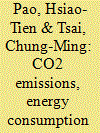

|
|
|
|
|
| Publication |
2010.
|
| Summary/Abstract |
This paper examines dynamic causal relationships between pollutant emissions, energy consumption and output for a panel of BRIC countries over the period 1971-2005, except for Russia (1990-2005). In long-run equilibrium energy consumption has a positive and statistically significant impact on emissions, while real output exhibits the inverted U-shape pattern associated with the Environmental Kuznets Curve (EKC) hypothesis with the threshold income of 5.393 (in logarithms). In the short term, changes in emissions are driven mostly by the error correction term and short term energy consumption shocks, as opposed to short term output shocks for each country. Short-term deviations from the long term equilibrium take from 0.770 years (Russia) to 5.848 years (Brazil) to correct. The panel causality results indicate there are energy consumption-emissions bidirectional strong causality and energy consumption-output bidirectional long-run causality, along with unidirectional both strong and short-run causalities from emissions and energy consumption, respectively, to output. Overall, in order to reduce emissions and not to adversely affect economic growth, increasing both energy supply investment and energy efficiency, and stepping up energy conservation policies to reduce unnecessary wastage of energy can be initiated for energy-dependent BRIC countries.
|
|
|
|
|
|
|
|
|
|
|
|
|
|
|
|
| 7 |
ID:
101455
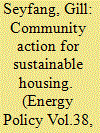

|
|
|
|
|
| Publication |
2010.
|
| Summary/Abstract |
This paper presents a new analytical framework of 'grassroots innovations' which views community-led initiatives for sustainable development as strategic green niches with the potential for wider transformation of mainstream society. This framework is applied to a low-carbon, low-impact, community-based sustainable housing initiative in the USA that pioneers straw bale housing techniques within a strong community-building ethos. The project is evaluated according to New Economics criteria of sustainable consumption, and is found to be successful at localising the construction supply chain, reducing ecological footprints, community-building, enabling collective action and building new institutions and systems of provision around housebuilding. However, viewing it as a strategic niche with aim to influence wider society, it is clear that it faces significant challenges in diffusing its ideas and practices beyond the niche. Its model is not necessarily suitable for scaling up or widespread replication; however, the scope for niche lessons to be adopted by mainstream builders is greater, given a supportive policy environment. Recognising the innovative nature of green niches at the policy level could lead to new approaches to governance of bottom-up community action for sustainable development.
|
|
|
|
|
|
|
|
|
|
|
|
|
|
|
|
| 8 |
ID:
101429


|
|
|
|
|
| Publication |
2010.
|
| Summary/Abstract |
Low carbon development (LCD) is a much used word in development circles today. As such, governments are actively exploring how to achieve their growth targets through a low carbon trajectory or even through a 'carbon neutral' pathway. This is a new area that challenges how development has been done so far, calling for not only a serious rethink of old practices but also contesting entrenched value systems. In this viewpoint, we explore some of the underlying issues that are driving the process of mainstreaming climate change in development. Recognising that there are variations in LCD, we map out the diversity of understandings and interpretations with a view to lay out the range of possibilities that countries can consider. We argue that whilst countries should certainly draw lessons from the experiences of others on mainstreaming climate change in their policies and practices, the version of LCD that each country follows needs to emerge from within its own national reality, anchored in its development prospects, aspirations and capacities.
|
|
|
|
|
|
|
|
|
|
|
|
|
|
|
|
| 9 |
ID:
101452
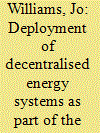

|
|
|
|
|
| Publication |
2010.
|
| Summary/Abstract |
The housing growth programme could offer an opportunity for accelerating the deployment of decentralised renewable energy systems (DRES) in the UK. The Government hopes to leverage private sector investment into DRES as part of new housing projects. The aim of this paper is to assess whether current regulatory and funding frameworks are sufficient to achieve this. The question is explored by drawing on the experience of developers, local authorities, energy utilities and service companies operating in the largest housing growth region in the UK-Thames Gateway. Their experience suggests that the current low intervention approach will be insufficient to generate the shift required in both industries. In order to be more successful economic and regulatory instruments should focus on producers (house-builders and energy providers) rather than consumers (households). Tighter regulation is needed to ensure that producers have a responsibility to install DRES as part of new developments, to enable connection to the grid, to ensure a sustained financial return from investment and revenue is spent on the expansion of new renewable energy infrastructure. This regulatory framework must be under-pinned by substantial funds focused on producers. Greater intervention is needed if DRES is to be included in new housing development.
|
|
|
|
|
|
|
|
|
|
|
|
|
|
|
|
| 10 |
ID:
101486


|
|
|
|
|
| Publication |
2010.
|
| Summary/Abstract |
We propose a conceptual framework for understanding the (lack of) energy saving efforts of private households based on Bandura's (1986) social cognitive theory. Results from applying this framework on a sample of Danish private electricity consumers are presented and it is concluded (a) that households' electricity consumption depends on both structural and motivational factors, (b) that their electricity saving effort depends on the strength of their internalized norms or self-expectations and on self-efficacy related factors, and (c) that there are predictable patterns of interaction among household members that influence their electricity consumption. The results suggest two approaches to promote electricity saving in households: (1) to change the socio-structural environment to be more facilitating for energy saving and empower householders to be more effective in their striving towards this goal through improved feedback about their household's electricity consumption and (2) social norms marketing, communicating social expectations and others' successful electricity saving achievements.
|
|
|
|
|
|
|
|
|
|
|
|
|
|
|
|
| 11 |
ID:
101489


|
|
|
|
|
| Publication |
2010.
|
| Summary/Abstract |
This paper reports the greenhouse gas (GHG) emission intensity of the New Zealand (NZ) manufacturing sector at a combination of industry group and class levels (sub-sectors). The short-run impacts of a price on emissions are investigated with a focus on exporting activities. Sub-sectors that could be materially impacted by an expected range of emissions prices accounted for slightly over 9% of national gross domestic product. It is found that there is much variability of emission intensity within manufacturing and even within sub-sectors. An assessment of trade intensities further indicates that several emissions-intensive activities are also export-intensive. These activities are at most risk of losing competitiveness in the short-run if they are subjected to a price on GHG emissions that their competitors in other countries are not. Emissions reduction policies must take account of trade competitiveness imperatives if NZ is to meet its international GHG emissions target while maintaining manufacturing sector competitiveness.
|
|
|
|
|
|
|
|
|
|
|
|
|
|
|
|
| 12 |
ID:
101464


|
|
|
|
|
| Publication |
2010.
|
| Summary/Abstract |
This paper constructs a comprehensive dataset of oil and total energy embedded in world trade of manufacturing goods for 73 countries from 1978 to 2000. Applying the data to debates on the dependency on foreign energy sources makes clear that achieving complete energy independence in the foreseeable future is unlikely to be feasible and may not be desirable. Applying it to the discussion of environmental Kuznets curves (EKCs) highlights an important distinction between production and consumption of energy. Richer countries use relatively less energy in their industrial production yet still consume relatively large amounts of energy indirectly. A further investigation largely excludes structural shifts of production in and out of the manufacturing sector as an explanation for the downward-sloping portion of the EKC. Country-level analyses add caveats but show tentative support for the cross-country conclusions.
|
|
|
|
|
|
|
|
|
|
|
|
|
|
|
|
| 13 |
ID:
101511
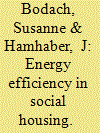

|
|
|
|
|
| Publication |
2010.
|
| Summary/Abstract |
This paper investigates the energy efficiency in a segment of the building sector in emerging countries by analyzing and evaluating the energy efficiency of a social housing project in Brazil. Energy efficiency measures and bioclimatic design strategies are developed in order to improve thermal comfort in this social housing project and to reduce the energy consumption and expenses of their residents. The institutional barriers and constraints toward higher efficiency are described. The results of this study show that there is a high potential to increase energy efficiency in social housing in emerging countries like Brazil. The implementation and consideration of the energy efficiency measures and policy recommendations would contribute substantially to the goal to dampen the fast growth of energy demand in these countries. Moreover the improvement of energy efficiency in the social housing sector could be a driver for market transformation towards more sustainability in the whole building sector.
Research highlights
?There is a high potential to increase energy efficiency in social housing in Brazil. ?Energy-efficient social housing would contribute substantially to dampen the fast growth of energy consumption in emerging countries like Brazil. ?Implementation of energy efficiency would improve the income situation of the poorest strata of the population.
|
|
|
|
|
|
|
|
|
|
|
|
|
|
|
|
| 14 |
ID:
101484


|
|
|
|
|
| Publication |
2010.
|
| Summary/Abstract |
This paper provides an insight into energy efficiency interventions studies, focusing on issues arising in UK higher education institutions (HEIs) in particular. Based on a review of the context for energy efficiency and carbon reduction programmes in the UK and the trends in higher education sector, existing external and internal policies and initiatives and their relevant issues are extensively discussed. To explore the efficacy of some internal intervention strategies, such as technical, non-technical and management interventions, a survey was conducted among UK higher education institutions between February and April 2008. Consultation responses show that there are a relatively high percentage of institutions (83%) that have embarked on both technical and non-technical initiatives, which is a demonstration to the joined-up approach in such area. Major barriers for intervention studies are also identified, including lack of methodology, non-clarity of energy demand and consumption issues, difficulty in establishing assessment boundaries, problems with regards to indices and their effectiveness and so on. Besides establishing clear targets for carbon reductions within the sector, it is concluded that it is important to develop systems for effectively measuring and evaluating the impact of different policies, regulations and schemes in the future as the first step to explore.
|
|
|
|
|
|
|
|
|
|
|
|
|
|
|
|
| 15 |
ID:
101507
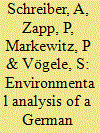

|
|
|
|
|
| Publication |
2010.
|
| Summary/Abstract |
This paper combines an existing projection of the development of electricity production with a technology-specific environmental assessment. The combination of these two approaches, which so far have only been performed separately, allows a discussion about environmental effects of carbon capture and storage (CCS) implementation strategies on a national level. The results identify the future role of lignite and hard coal in German power production. The implementation of CCS technology leads to a considerable loss of efficiency. Due to CCS, about 50 million t of lignite will be additionally required in 2030 in comparison to the reference case without CCS in 2010. Increasing demand, the replacement of old plants and the compensation of efficiency losses lead to highly ambitious expansion rates. In the case of CCS implementation, the global warming potential (GWP) can be reduced by up to 70%. However, other environmental impacts increase in part considerably. Compliance with national ceilings for NOx emissions can only be reached by compensation measures in other sectors. The results of the environmental assessment demonstrate the significant role of the coal composition, coal origin and the required transport. CO2 pipeline transport and CO2 storage make a fairly minor contribution to the overall environmental impact.
|
|
|
|
|
|
|
|
|
|
|
|
|
|
|
|
| 16 |
ID:
101516


|
|
|
|
|
| Publication |
2010.
|
| Summary/Abstract |
The EU Electricity Directive requires that consumers be provided information about the sources from which the electricity is produced, as well as about the CO2 emissions and the radioactive waste resulting from production sources. In this paper we examine the effectiveness of this information strategy based on a case study focusing on Norwegian enterprises. We explore the views of selected companies on the electricity disclosure scheme. We examine how effective the disclosure scheme is in informing and stimulating companies to buy green electricity products, and link this to what we know about the effects of information disclosure from the literature. Our results show that the information disclosed does to a little extent reach the businesses, and that firms express distrust in the system of Guarantees of Origin (GoO), which leads to distrust in the relevance of the information given through the disclosure scheme.
|
|
|
|
|
|
|
|
|
|
|
|
|
|
|
|
| 17 |
ID:
101503


|
|
|
|
|
| Publication |
2010.
|
| Summary/Abstract |
The widening gap between EU gas production and consumption may require an 87% increase of import volumes between 2006 and 2030, and there are great uncertainties regarding the amounts of gas that can be expected from new suppliers. The potential of increased production from Norway and Algeria is limited; hence, Russia is likely to play a crucial part of meeting the anticipated growing gas demand of the EU. A field-by-field study of 83 giant gas fields shows that the major producing Russian gas fields are in decline, and by 2013 much larger supplies from the Yamal Peninsula and the Shtokman field will be needed in order to avoid a decline in production. Gas from fields in Eastern Siberia and the Far East will mainly be directed to the Asian and Pacific Rim markets, thereby limiting its relevance to the European and CIS markets. As a result, the maximum export increase to the European and CIS markets amounts only to about 45% for the period 2015-2030. The discourse surrounding the EU's dependence on Russian gas should thus not only be concerned with geopolitics, but also with the issue of resource limitations.
|
|
|
|
|
|
|
|
|
|
|
|
|
|
|
|
| 18 |
ID:
101460


|
|
|
|
|
| Publication |
2010.
|
| Summary/Abstract |
Transformational energy and climate policies are being debated worldwide that could have significant impact upon the future of the forest products industry. Because woody biomass can produce alternative transportation fuels, low-carbon electricity, and numerous other "green" products in addition to traditional paper and lumber commodities, the future use of forest resources is highly uncertain. Using the National Energy Modeling System (NEMS), this paper assesses the future of the forest products industry under three possible U.S. policy scenarios: (1) a national renewable electricity standard, (2) a national policy of carbon constraints, and (3) incentives for industrial energy efficiency. In addition, we discuss how these policy scenarios might interface with the recently strengthened U.S. renewable fuels standards. The principal focus is on how forest products including residues might be utilized under different policy scenarios, and what such market shifts might mean for electricity and biomass prices, as well as energy consumption and carbon emissions. The results underscore the value of incentivizing energy efficiency in a portfolio of energy and climate policies in order to moderate electricity and biomass price escalation while strengthening energy security and reducing CO2 emissions.
|
|
|
|
|
|
|
|
|
|
|
|
|
|
|
|
| 19 |
ID:
101437


|
|
|
|
|
| Publication |
2010.
|
| Summary/Abstract |
Community energy initiatives offer a potentially important means for reshaping the electrical system in a manner compatible with emissions reduction goals. Many such initiatives, however, focus upon top-down, institutionally structured approaches that understand community residents as atomistic, economically motivated, and minimally engaged. This paper examines a number of case studies that are based upon a bottom-up approach rooted in a civic culture that seeks to maximize the capacities of an active and engaged citizenry. The paper focuses upon two mutually dependent issues: first, recruiting community members, and second, sustaining their participation.
|
|
|
|
|
|
|
|
|
|
|
|
|
|
|
|
| 20 |
ID:
101463


|
|
|
|
|
| Publication |
2010.
|
| Summary/Abstract |
It is generally understood that the pattern of repeated expiration and short-term renewal of the federal production tax credit (PTC) causes a boom-bust cycle in wind power plant investment in the US. This on-off pattern is detrimental to the wind industry, since ramp-up and ramp-down costs are high, and players are deterred from making long-term investments. It is often assumed that the severe downturn in investment during "off" years implies that wind power is unviable without the PTC. This assumption turns out to be unsubstantiated: this paper demonstrates that it is not the absence of the PTC that causes the investment downturn during "off" years, but rather the uncertainty over its return. Specifically, it is the dynamic of power purchase agreement (PPA) negotiations in the face of PTC renewal uncertainty that drives investment volatility. With contract negotiations prevalent in the renewable energy industry, this finding suggests that reducing uncertainty is a crucial component of effective renewable energy policy. The PTC as currently structured is not the only means, existing or potential, for encouraging wind power investment. Using data from a survey of energy professionals, various policy instruments are compared in terms of their perceived stability for supporting long-term investment.
|
|
|
|
|
|
|
|
|
|
|
|
|
|
|
|
|
|
|
|
|